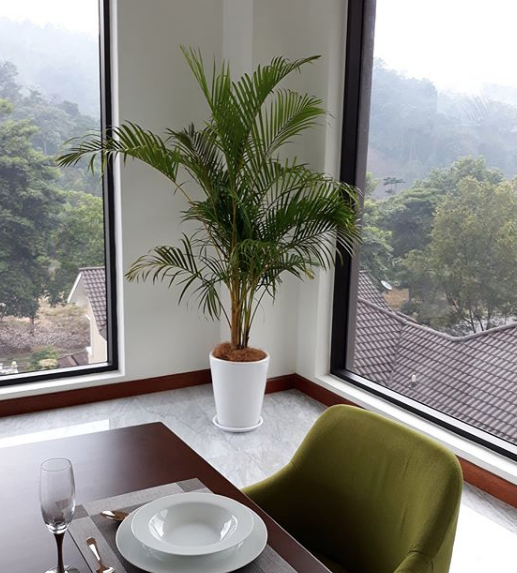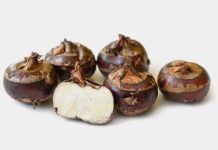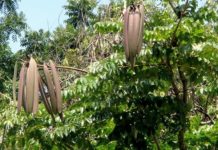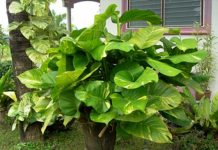Last Updated on 14 ธันวาคม 2022 by puechkaset
Yellow palm is a species of ornamental palms that is commonly planted in the houses or garden plots because of its beautiful greenish-yellow petioles and leaves. Its stem is not very tall. It lives long and can be easily planted and taken care of.
• Family : Palmae (Arecaceae)
• Scientific name : Chrysalidocarpus lutescens.
• Common name :
– Yellow palm
– Yellow cane palm
– Golden cane palm
– Butterfly palm
– Madagascar palm
Origin and spreading
This plant is native to the Islands of Madagascar. Currently, it is planted around the world in particular tropical countries, including Thailand.
Botanical characteristics
Stem
This plant has a circular and straight stem that sprouts as new clumps around its original stem. When it grows completely, it can be up to 8 meters tall and its stem size is about 4-8 cm. Its stem has clear segments with smooth surface. Stem base is yellow, orange or yellowish green while stem apex is white.

Leaf
Its leaves are pinnatifid compound leaves and leaf sheaths cover around the stem and are yellowish-orange arranged based on the height. Leaf foliar is 1.5-2 meters long and is light or yellowish green. There are small leaves on this leaf foliar that are alternately arranged in rows. These small leave are attenuated. Leaf base is cuneate and leaf apex is attenuated like coconut leaves. Its leaves are about 1-2 cm wide and 40-60 cm long. Leaf blade and margin are smooth and yellowish green.
Flower
This plant blooms as a bouquet like those of general palms. Its peduncle is about 60-100 centimeters long and there are small bouquets produced at the bouquet apex. There are several white small flowers on these small bouquets. Flowers of this plant are imperfect flowers and its stamens and pollens are at different stems.
Fruit
Its fruits are produced as a bouquet and each fruit is round and oval with a size of about 1-1.5 cm. Its raw fruit is green, its ripe fruit turns into yellowish orange, and its fully ripe fruit turns into blackish purple. Each fruit contains one seed.
Benefits of Yellow palm
1. This plant is commonly grown in the garden plots for landscaping purpose and in the pots as an ornamental plant because of its beautiful shrubs, long and curved foliar, and beautiful yellowish-green leaves. For planting in a pot, the pot should be placed in the shade or an area where sunlight does not shine all day or an area with dim light, such as in the house or shaded area in front of or beside the house, because planting in the pots will lose moisture more easily than planting in the garden plots.
2. It is grown as a sacred plant with the following beliefs:
– It will cause other people to pay respect and obey oneself like its curved petioles. In addition, it will make family members as good, kind and humble ones.
– Its greenish-yellow or golden leaves will promote the wealth and fortune to its planters or family members.
3. In addition to ornament or decoration, some farmers also grow this plant to cut and sell its petioles to make good income. These petioles can be used to decorate several ceremonies, such as sacred events, community festivals, and government’s important events.
4. Its branches can be used to rub or dip on the soles of the feet to detect numbness due to diabetes and to reduce the risk of diabetic wounds. To do this, its branches are peeled out and only its young core remains before sharpening its apex into slim and round shape and dipping on the soles of the feet.
Health Benefits of Yellow palm
Its young fruit is astringent and has the following properties:
– Appetite
– Expectoration and cough relief
– Relief of being drunk and dizzy
– Relief of nausea and vomiting
– Anthelmintics
Its raw fruit is peeled out before chewing its flesh with betel nuts. It is strongly astringent and has the following properties:
– Relief of diarrhea
– Anthelmintics
– Diuretic aid
Its fruit flesh is sweet and tasteless and has the following properties:
– Diuretic aid
– Relief of flatulence and carminative aid
– Relief of dysentery or diarrhea
Its young fruit and flesh of mature fruit are for external application and have the following properties:
– Fruit flesh is ground to apply and heal a wound quickly
– Treatment of skin diseases and ringworms
Planting and Growing Yellow palm
This plant can be propagated and planted in two ways: planting with seeds and shoots. It is a plant that needs loam or loose soil and can be resistant to drought. It can be grown both in the shaded and outdoor areas. However, it generally likes dim light and comfortable weather (not too hot); therefore, it is mostly planted for decoration in the buildings or in the shaded areas.
Soil and land preparation
Soil for planting in a pot should be mixed with other organic materials in order to help increase organic matters and keep the moisture in soil because planting in a pot can lose the moisture easily. This soil should be mixed with farm yard manure, black rice husks and coco-coir dusts at a ratio of 1:2:1:0.5:0.5 by using loam or loose soil as main component and mixing them together before packing into the pot.
Weeds in an open planting plot should be eliminated. Then, one kilogram of farm yard manure and one kilogram of black rice husks are put into every one square meter of area and mixed together before planting.
Seedling
Its fully ripe or dry dehiscent fruit is kept for 1-2 months for dormancy of its seeds before planting in a planting plot that consists of the same planting materials as those used in a pot. The whole fruit without being peeled out is used. When its seedling is produced, it should be taken care of until its stem is 3-5 centimeters tall before moving it to a planting pot or bag. In addition, three to five seeds may be planted in a planting pot or bag until they are mature in the pot before moving to the planting plot.
Separation of shoots
A shoot with a height of not less than 30 cm is separated into a planting pot or plot by digging and cutting its root only.
Watering
Planting in a pot should be watered at least once every 3 days in a sufficient quantity.
Planting in a plot should be watered at least every 5-7 days.
Fertilization
Fertilization should be done twice a year by mainly emphasizing on farm yard manure supplemented by chemical fertilizer in the formula of 16-8-8 about one handful per one plant, depending on the stem size.




